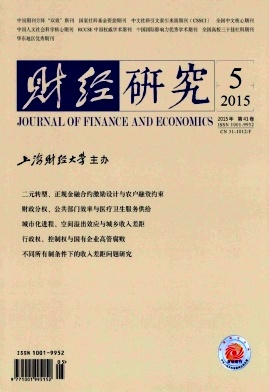生产性服务业集聚与城市经济绩效——基于行业和地区异质性视角的分析
财经研究 2015 年 第 41 卷第 05 期, 页码:
摘要
参考文献
摘要
文章从行业和地区异质性视角入手,基于2003-2012年城市面板数据,运用门槛面板模型检验生产性服务业集聚与城市经济效率的关系。结果表明:高端生产性服务业集聚对城市经济效率具有显著的促进作用,且这种作用取决于城市规模;经济总量跨越了门槛的城市可以从高端生产性服务业与大城市的知识溢出效应及更好的上下游关联产业匹配中提高效率,城市经济总量越大,集聚效益越显著;而低端生产性服务业集聚对城市经济效率的影响在总体上并不显著,随经济体量的扩大呈现倒U形变化。此结果意味着不同等级的城市适合发展不同层次的生产性服务业,经济较发达的大城市需要鼓励高端生产性服务业集聚发展,而经济规模较小的城市应避免盲目追求产业结构的高级化。
[1]蔡伟毅, 陈学识. 国际知识溢出与中国技术进步[J]. 数量经济技术经济研究, 2010, (6): 57-71.
[2]陈建军, 陈国亮, 黄洁. 新经济地理学视角下的生产性服务业集聚及其影响因素研究——来自中国222个城市的经验证据[J]. 管理世界, 2009, (4): 83-95.
[3]顾乃华. 我国城市生产性服务业集聚对工业的外溢效应及其区域边界——基于HLM模型的实证研究[J]. 财贸经济, 2011, (5): 115-122.
[4]柯善咨, 赵曜. 产业结构、城市规模与中国城市生产率[J]. 经济研究, 2014, (4): 76-88.
[5]李建华, 孙蚌珠. 服务业的结构和“成本病”的克服——Baumol模型的扩展和实证[J]. 财经研究, 2012, (11): 27-37.
[6]单豪杰. 中国资本存量K的再估算:1952-2006年[J]. 数量经济技术经济研究, 2008, (10): 17-31.
[7]盛丰. 生产性服务业集聚与制造业升级:机制与经验——来自230个城市数据的空间计量分析[J]. 产业经济研究, 2014, (2): 32-39.
[8]宣烨. 生产性服务业空间集聚与制造业效率提升——基于空间外溢效应的实证研究[J]. 财贸经济, 2012, (4): 121-128.
[9]宣烨, 余泳泽. 生产性服务业层级分工对制造业效率提升的影响——基于长三角地区38城市的经验分析[J]. 产业经济研究, 2014, (3): 1-10.
[10]Behrens K, Duranton G, RobertNicoud F. Productive cities: Sorting, selection, and agglomeration[J]. Journal of Political Economy, 2014, 122(3): 507-553.
[11]Bronzini R, Piselli P. Determinants of longrun regional productivity with geographical spillovers:The role of R&D, human capital and public infrastructure[J]. Regional Science and Urban Economics, 2009, 39(2): 187-199.
[12]Browning H L, Singelmann J. The emergence of a service society:Demographic and sociological aspects of the sectoral transformation of the labor force in the U.S.A.[M]. Springfield: National Technical Information Service, 1975.
[13]Coe D T, Helpman E. International R&D spillovers[J]. European Economic Review, 1995, 39(5): 859-887.
[14]Combes P, Duranton G, Gobillon L, et al. The productivity advantages of large cities:Distinguishing agglomeration from firm selection[J]. Econometrica, 2012, 80(6): 2543-2594.
[15]Duranton G, Puga D. From sectoral to functional urban specialisation[J]. Journal of Urban Economics, 2005, 57(2): 343-370.
[16]Eswaran M, Kotwal A. The role of the service sector in the process of industrialization[J]. Journal of Development Economics, 2002, 68(2): 401-420.
[17]Glaeser E L. Learning in cities[J]. Journal of Urban Economics, 1999, 46(2): 254-277.
[18]Hansen B E. Threshold effects in nondynamic panels:Estimation, testing, and inference[J]. Journal of Econometrics, 1999, 93(2): 345-368.
[19]Illeris S, Philippe J. Introduction:The role of services in regional economic growth[J]. The Service Industries Journal, 1993, 13(2): 3-10.
[20]Jacobs W, Koster H R A, Van Oort F. Coagglomeration of knowledgeintensive business services and multinational enterprises[J]. Journal of Economic Geography, 2014, 14 (2): 443-475.
[21]Markusen J R. Trade in producer services and in other specialized intermediate inputs[J]. American Economic Review, 1989, 79(1): 85-95.
[22]World Bank. World development report 2009: Reshaping economic geography[M]. Washington, DC: World Bank Publications, 2009.
[2]陈建军, 陈国亮, 黄洁. 新经济地理学视角下的生产性服务业集聚及其影响因素研究——来自中国222个城市的经验证据[J]. 管理世界, 2009, (4): 83-95.
[3]顾乃华. 我国城市生产性服务业集聚对工业的外溢效应及其区域边界——基于HLM模型的实证研究[J]. 财贸经济, 2011, (5): 115-122.
[4]柯善咨, 赵曜. 产业结构、城市规模与中国城市生产率[J]. 经济研究, 2014, (4): 76-88.
[5]李建华, 孙蚌珠. 服务业的结构和“成本病”的克服——Baumol模型的扩展和实证[J]. 财经研究, 2012, (11): 27-37.
[6]单豪杰. 中国资本存量K的再估算:1952-2006年[J]. 数量经济技术经济研究, 2008, (10): 17-31.
[7]盛丰. 生产性服务业集聚与制造业升级:机制与经验——来自230个城市数据的空间计量分析[J]. 产业经济研究, 2014, (2): 32-39.
[8]宣烨. 生产性服务业空间集聚与制造业效率提升——基于空间外溢效应的实证研究[J]. 财贸经济, 2012, (4): 121-128.
[9]宣烨, 余泳泽. 生产性服务业层级分工对制造业效率提升的影响——基于长三角地区38城市的经验分析[J]. 产业经济研究, 2014, (3): 1-10.
[10]Behrens K, Duranton G, RobertNicoud F. Productive cities: Sorting, selection, and agglomeration[J]. Journal of Political Economy, 2014, 122(3): 507-553.
[11]Bronzini R, Piselli P. Determinants of longrun regional productivity with geographical spillovers:The role of R&D, human capital and public infrastructure[J]. Regional Science and Urban Economics, 2009, 39(2): 187-199.
[12]Browning H L, Singelmann J. The emergence of a service society:Demographic and sociological aspects of the sectoral transformation of the labor force in the U.S.A.[M]. Springfield: National Technical Information Service, 1975.
[13]Coe D T, Helpman E. International R&D spillovers[J]. European Economic Review, 1995, 39(5): 859-887.
[14]Combes P, Duranton G, Gobillon L, et al. The productivity advantages of large cities:Distinguishing agglomeration from firm selection[J]. Econometrica, 2012, 80(6): 2543-2594.
[15]Duranton G, Puga D. From sectoral to functional urban specialisation[J]. Journal of Urban Economics, 2005, 57(2): 343-370.
[16]Eswaran M, Kotwal A. The role of the service sector in the process of industrialization[J]. Journal of Development Economics, 2002, 68(2): 401-420.
[17]Glaeser E L. Learning in cities[J]. Journal of Urban Economics, 1999, 46(2): 254-277.
[18]Hansen B E. Threshold effects in nondynamic panels:Estimation, testing, and inference[J]. Journal of Econometrics, 1999, 93(2): 345-368.
[19]Illeris S, Philippe J. Introduction:The role of services in regional economic growth[J]. The Service Industries Journal, 1993, 13(2): 3-10.
[20]Jacobs W, Koster H R A, Van Oort F. Coagglomeration of knowledgeintensive business services and multinational enterprises[J]. Journal of Economic Geography, 2014, 14 (2): 443-475.
[21]Markusen J R. Trade in producer services and in other specialized intermediate inputs[J]. American Economic Review, 1989, 79(1): 85-95.
[22]World Bank. World development report 2009: Reshaping economic geography[M]. Washington, DC: World Bank Publications, 2009.
引用本文
张浩然. 生产性服务业集聚与城市经济绩效——基于行业和地区异质性视角的分析[J]. 财经研究, 2015, 41(5): 0.
导出参考文献,格式为:
下一篇:行政权、控制权与国有企业高管腐败





 8245
8245  3781
3781

